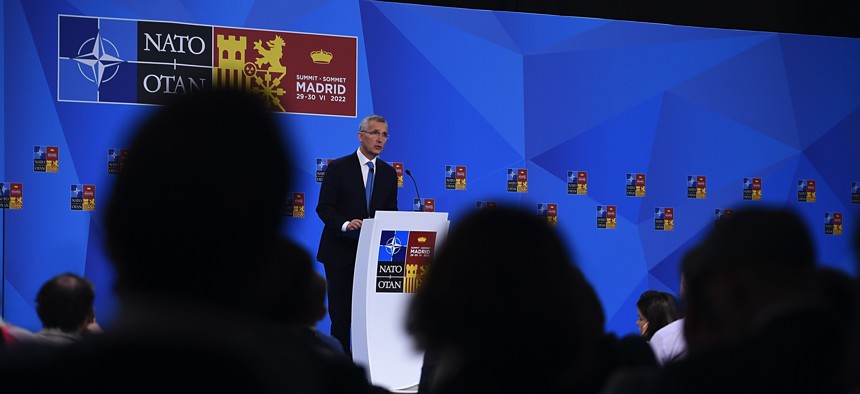
NATO Secretary General Jens Stoltenberg holds a press conference at the NATO Summit on June 29, 2022, in Madrid, Spain. Denis Doyle/Getty Images
US Boosts Forces In Europe As NATO Names Russia ‘Most Significant and Direct Threat’
The Pentagon will also base more destroyers in Spain and F-35s in the United Kingdom.
The Pentagon will further increase its presence in Europe in response to Russia’s aggression in Ukraine, the Defense Department announced Wednesday.
The moves follow NATO’s decision to name Moscow “the most significant and direct threat to allies’ security and to peace and stability in the Euro-Atlantic area” in a new strategy agreed to at the summit in Madrid. The new strategy updates a 2010 document, in which NATO said it was pursuing “a true strategic partnership” with Russia, showing just how much the relationship has deteriorated over the past decade because of Moscow’s 2014 annexation of Crimea and February invasion of Ukraine.
The United States will change its troop presence in multiple eastern European allies, including permanently headquartering the Army’s V Corps in Poland and increasing training exercises and “heel-to-toe” deployments with Baltic allies, according to a Defense Department fact sheet. The Pentagon will also maintain the deployment of a brigade combat team in Romania, a change that was announced in February as Russia prepared to launch its invasion of Ukraine. The increased American presence is in addition to the NATO battlegroup that was stationed in Romania after Russia’s invasion.
The Defense Department is also boosting its forces in Germany and Italy. More than 600 troops will be stationed in Germany as part of an air defense artillery brigade headquarters, a short-range air defense battalion, a combat sustainment support battalion headquarters, and an engineer brigade headquarters. A short-range air defense battery will be stationed in Italy, adding about 65 personnel.
The Pentagon will also increase the equipment in the region, including stationing two additional Navy destroyers in Rota, Spain, and an additional squadron of F-35s at the Royal Air Force Lakenheath base in the United Kingdom.
There are currently more than 100,000 American troops in Europe. Celeste Wallander, the assistant defense secretary for international security affairs, would not share the total number of additional American troops that will be stationed in Europe “for security and operational planning reasons.”
Wallander told reporters that the additional troops in eastern Europe, including permanently headquartering V Corps in Poland, does not violate the NATO-Russia Founding Act, a 1997 document in which NATO committed not to permanently station troops on Russia’s border.
“The NATO-Russia Founding Act makes a commitment for no substantial combat forces,” she said. “Therefore, the decision to permanently forward station the V Corps Headquarters forward command post…it’s consistent with that commitment and our understanding of the NATO-Russia Founding Act.”
NATO’s new strategy also mentions China for the first time,” saying that its “ambitions and coercive policies challenge our interests, security, and values.”
The People’s Republic of China’s “malicious hybrid and cyber operations and its confrontational rhetoric and disinformation target allies and harm alliance security,” the strategy says, though it also says the alliance is “open to constructive engagement with the PRC.”
The strategy also addresses other challenges for the alliance, including fighting terrorism, investing in emerging technologies, and combating climate change. NATO Secretary General Jens Stoltenberg told reporters Wednesday that the alliance committed to cut emissions nearly in half by 2030 for its own platforms like AWACS surveillance planes and its Brussels headquarters. The alliance also aims to reach net zero by 2050.
“We can not choose between having green militaries or strong militaries. They must be both,” Stoltenberg said.




